Post Syndicated from Louis Poinsignon original https://blog.cloudflare.com/rpki-2020-fall-update/
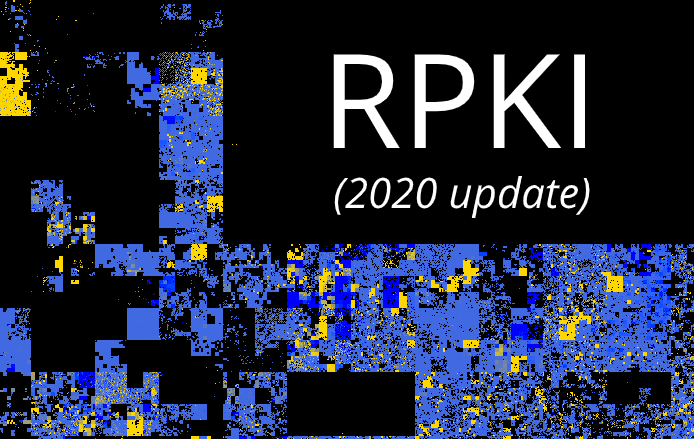
The Internet is a network of networks. In order to find the path between two points and exchange data, the network devices rely on the information from their peers. This information consists of IP addresses and Autonomous Systems (AS) which announce the addresses using Border Gateway Protocol (BGP).
One problem arises from this design: what protects against a malevolent peer who decides to announce incorrect information? The damage caused by route hijacks can be major.
Routing Public Key Infrastructure (RPKI) is a framework created in 2008. Its goal is to provide a source of truth for Internet Resources (IP addresses) and ASes in signed cryptographically signed records called Route Origin Objects (ROA).
Recently, we’ve seen the significant threshold of two hundred thousands of ROAs being passed. This represents a big step in making the Internet more secure against accidental and deliberate BGP tampering.
We have talked about RPKI in the past but we thought it would be a good time for an update.
In a more technical context, the RPKI framework consists of two parts:
- IP addresses need to be cryptographically signed by their owners in a database managed by a Trust Anchor: Afrinic, APNIC, ARIN, LACNIC and RIPE. Those five organizations are in charge of allocating Internet resources. The ROA indicates which Network Operator is allowed to announce the addresses using BGP.
- Network operators download the list of ROAs, perform the cryptographic checks and then apply filters on the prefixes they receive: this is called BGP Origin Validation.
The “Is BGP Safe Yet” website
The launch of the website isbgpsafeyet.com to test if your ISP correctly performs BGP Origin Validation was a success. Since launch, it has been visited more than five million times from over 223 countries and 13,000 unique networks (20% of the entire Internet), generating half a million BGP Origin Validation tests.
Many providers subsequently indicated on social media (for example, here or here) that they had an RPKI deployment in the works. This increase in Origin Validation by networks is increasing the security of the Internet globally.
The site’s test for Origin Validation consists of queries toward two addresses, one of which is behind an RPKI invalid prefix and the other behind an RPKI valid prefix. If the query towards the invalid succeeds, the test fails as the ISP does not implement Origin Validation. We counted the number of queries that failed to reach invalid.cloudflare.com. This also included a few thousand RIPE Atlas tests that were started by Cloudflare and various contributors, providing coverage for smaller networks.
Every month since launch we’ve seen that around 10 to 20 networks are deploying RPKI Origin Validation. Among the major providers we can build the following table:
| Month | Networks |
|---|---|
| August | Swisscom (Switzerland), Salt (Switzerland) |
| July | Telstra (Australia), Quadranet (USA), Videotron (Canada) |
| June | Colocrossing (USA), Get Norway (Norway), Vocus (Australia), Hurricane Electric (Worldwide), Cogent (Worldwide) |
| May | Sengked Fiber (Indonesia), Online.net (France), WebAfrica Networks (South Africa), CableNet (Cyprus), IDnet (Indonesia), Worldstream (Netherlands), GTT (Worldwide) |
With the help of many contributors, we have compiled a list of network operators and public statements at the top of the isbgpsafeyet.com page.
We excluded providers that manually blocked the traffic towards the prefix instead of using RPKI. Among the techniques we see are firewall filtering and manual prefix rejection. The filtering is often propagated to other customer ISPs. In a unique case, an ISP generated a “more-specific” blackhole route that leaked to multiple peers over the Internet.
The deployment of RPKI by major transit providers, also known as Tier 1, such as Cogent, GTT, Hurricane Electric, NTT and Telia made many downstream networks more secure without them having them deploying validation software.
Overall, we looked at the evolution of the successful tests per ASN and we noticed a steady increase over the recent months of 8%.
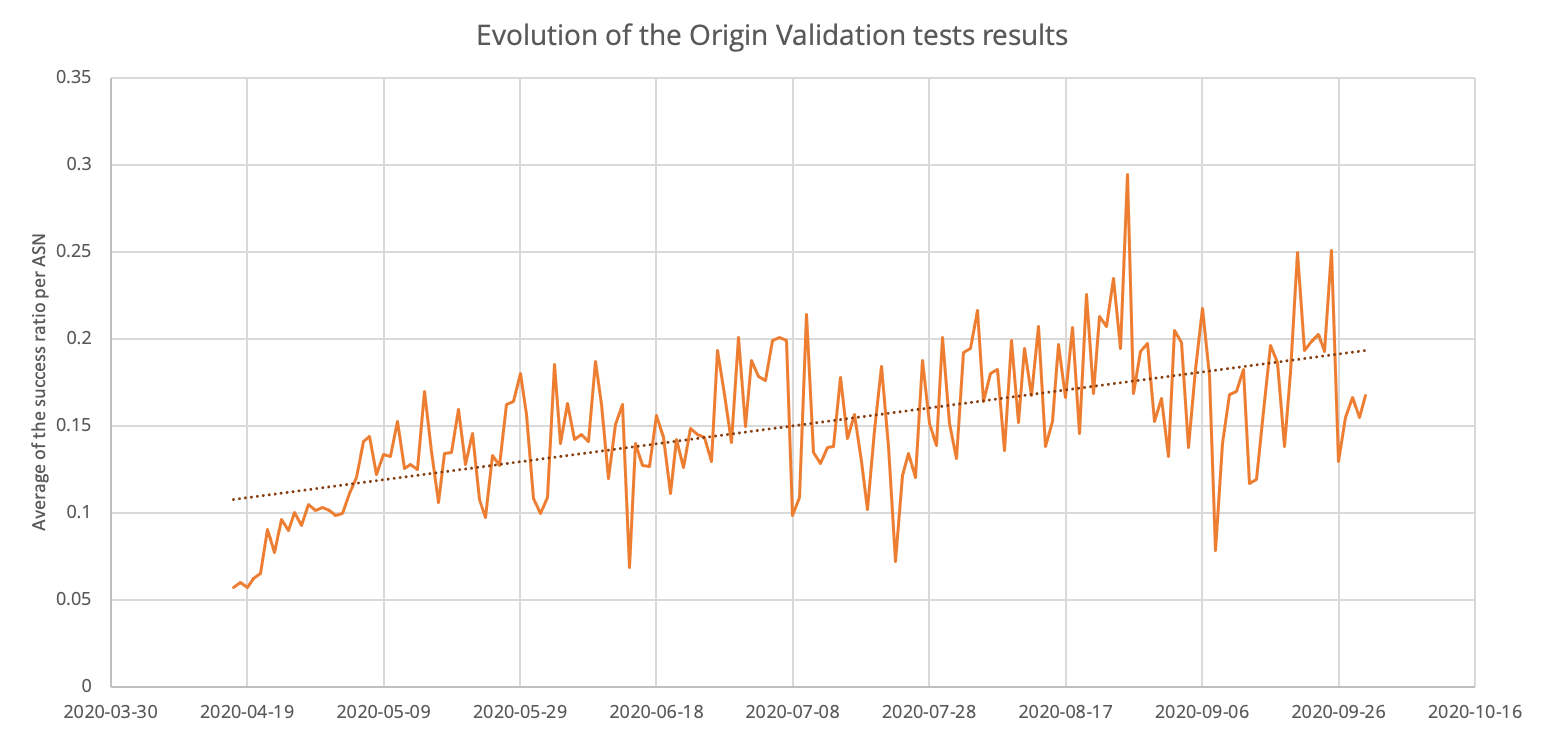
Furthermore, when we probed the entire IPv4 space this month, using a similar technique to the isbgpsafeyet.com test, many more networks were not able to reach an RPKI invalid prefix than compared to the same period last year. This confirms an increase of RPKI Origin Validation deployment across all network operators. The picture below shows the IPv4 space behind a network with RPKI Origin Validation enabled in yellow and the active space in blue. It uses a Hilbert Curve to efficiently plot IP addresses: for example one /20 prefix (4096 IPs) is a pixel, a /16 prefix (65536 IPs) will form a 4×4 pixels square.
The more the yellow spreads, the safer the Internet becomes.
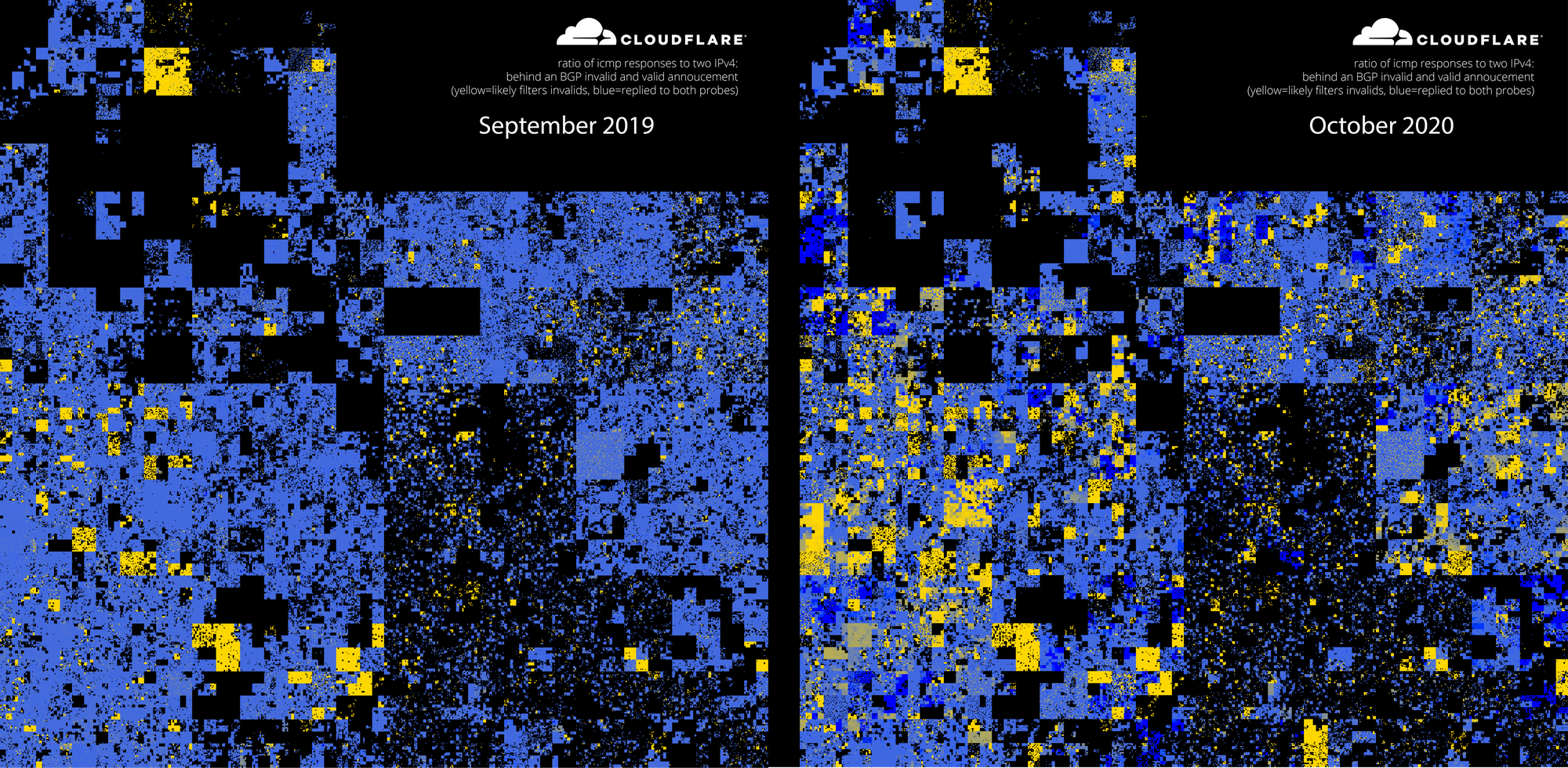
What does it mean exactly? If you were hijacking a prefix, the users behind the yellow space would likely not be affected. This also applies if you miss-sign your prefixes: you would not be able to reach the services or users behind the yellow space. Once RPKI is enabled everywhere, there will only be yellow squares.
Progression of signed prefixes
Owners of IP addresses indicate the networks allowed to announce them. They do this by signing prefixes: they create Route Origin Objects (ROA). As of today, there are more than 200,000 ROAs. The distribution shows that the RIPE region is still leading in ROA count, then followed by the APNIC region.

2020 started with 172,000 records and the count is getting close to 200,000 at the beginning of November, approximately a quarter of all the Internet routes. Since last year, the database of ROAs grew by more than 70 percent, from 100,000 records, an average pace of 5% every month.
On the following graph of unique ROAs count per day, we can see two points that were followed by a change in ROA creation rate: 140/day, then 231/day, and since August, 351 new ROAs per day.
It is not yet clear what caused the increase in August.

Free services and software
In 2018 and 2019, Cloudflare was impacted by BGP route hijacks. Both could have been avoided with RPKI. Not long after the first incident, we started signing prefixes and developing RPKI software. It was necessary to make BGP safer and we wanted to do more than talk about it. But we also needed enough networks to be deploying RPKI as well. By making deployment easier for everyone, we hoped to increase adoption.
The following is a reminder of what we built over the years around RPKI and how it grew.
OctoRPKI is Cloudflare’s open source RPKI Validation software. It periodically generates a JSON document of validated prefixes that we pass onto our routers using GoRTR. It generates most of the data behind the graphs here.
The latest version, 1.2.0, of OctoRPKI was released at the end of October. It implements important security fixes, better memory management and extended logging. This is the first validator to provide detailed information around cryptographically invalid records into Sentry and performance data in distributed tracing tools.
GoRTR remains heavily used in production, including by transit providers. It can natively connect to other validators like rpki-client.
When we released our public rpki.json endpoint in early 2019, the idea was to enable anyone to see what Cloudflare was filtering.
The file is also used as a bootstrap by GoRTR, so that users can test a deployment. The file is cached on more than 200 data centers, ensuring quick and secure delivery of a list of valid prefixes, making RPKI more accessible for smaller networks and developers.
Between March 2019 and November 2020, the number of queries more than doubled and there are five times more networks querying this file.
The growth of queries follows approximately the rate of ROA creation (~5% per month).

A public RTR server is also available on rtr.rpki.cloudflare.com. It includes a plaintext endpoint on port 8282 and an SSH endpoint on port 8283. This allows us to test new versions of GoRTR before release.
Later in 2019, we also built a public dashboard where you can see in-depth RPKI validation. With a GraphQL API, you can now explore the validation data, test a list of prefixes, or see the status of the current routing table.
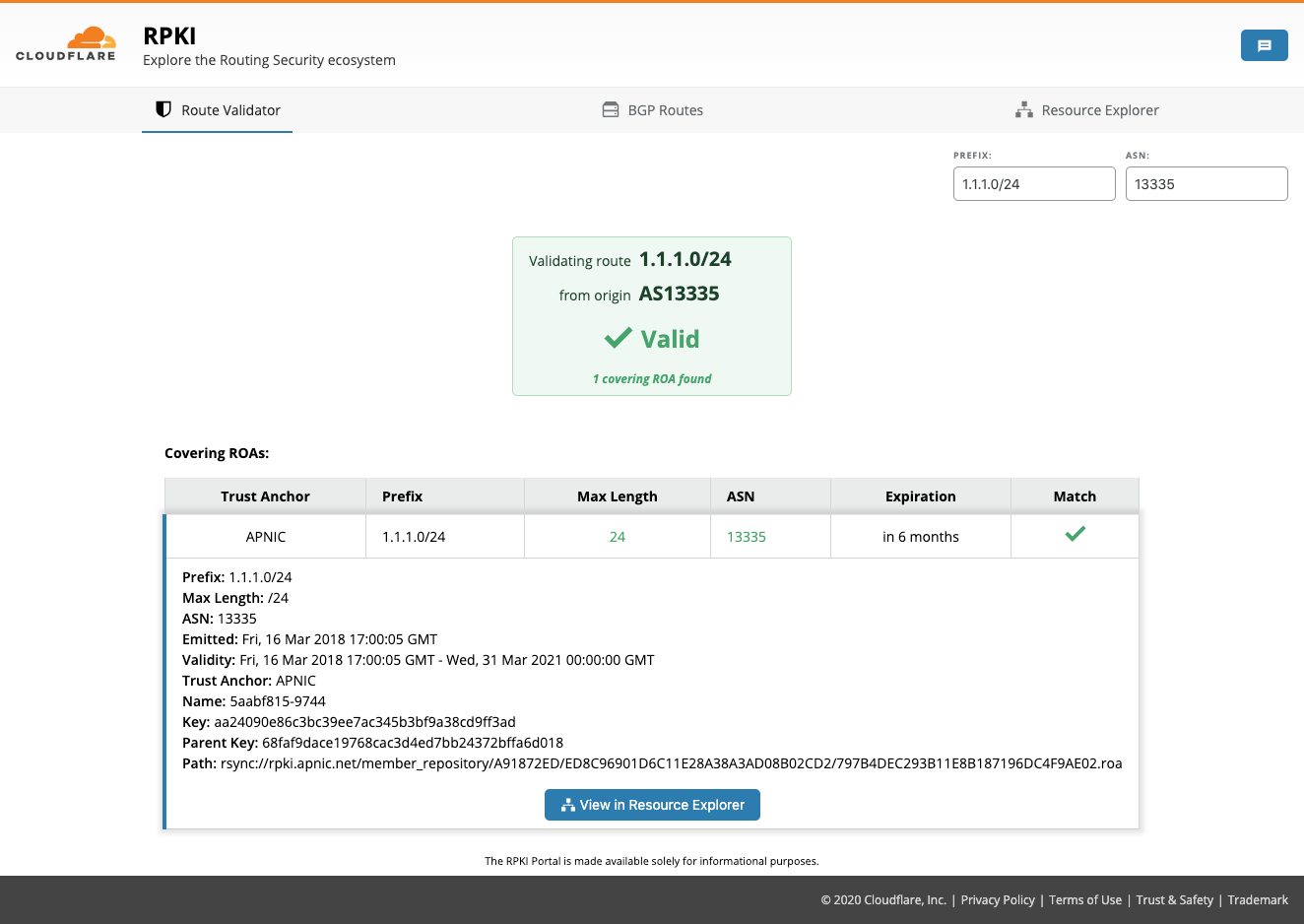
Currently, the API is used by BGPalerter, an open-source tool that detects routing issues (including hijacks!) from a stream of BGP updates.
Additionally, starting in November, you can access the historical data from May 2019. Data is computed daily and contains the unique records. The team behind the dashboard worked hard to provide a fast and accurate visualization of the daily ROA changes and the volumes of files changed over the day.
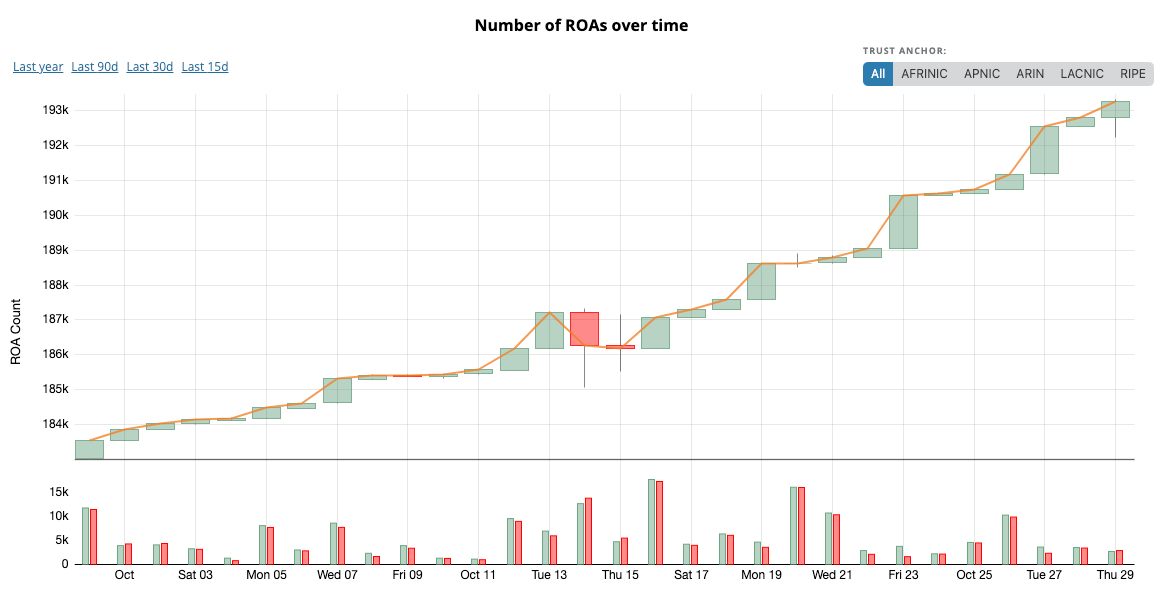
The future
We believe RPKI is going to continue growing, and we would like to thank the hundreds of network engineers around the world who are making the Internet routing more secure by deploying RPKI.
25% of routes are signed and 20% of the Internet is doing origin validation and those numbers grow everyday. We believe BGP will be safer before reaching 100% of deployment; for instance, once the remaining transit providers enable Origin Validation, it is unlikely a BGP hijack will make it to the front page of world news outlets.
While difficult to quantify, we believe that critical mass of protected resources will be reached in late 2021.
We will keep improving the tooling; OctoRPKI and GoRTR are open-source and we welcome contributions. In the near future, we plan on releasing a packaged version of GoRTR that can be directly installed on certain routers. Stay tuned!